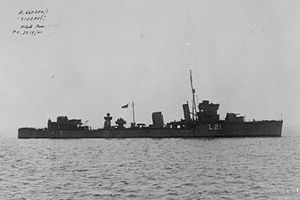HMS Viceroy (D91)

HMS Viceroy during World War II.
|
|
| History | |
|---|---|
|
|
|
| Class and type: | Admiralty W-class destroyer |
| Name: | HMS Viceroy |
| Namesake: | |
| Ordered: | 30 June 1916 or August 1916 |
| Builder: | John I. Thornycroft & Company, Woolston, Hampshire, England |
| Laid down: | 12 December 1916 |
| Launched: | 17 November 1917 |
| Completed: | 14 January 1918 |
| Commissioned: | 18 January 1918 |
| Decommissioned: | mid-1930s |
| Identification: |
|
| Recommissioned: | January 1941 |
| Decommissioned: | sometime after 15 August 1945 |
| Motto: | In the King's name |
| Honours and awards: |
|
| Fate: | Sold 15 May 1947 or June 1948 for scrapping |
| Badge: | The Star of India under a crown proper on a white field |
| General characteristics | |
| Displacement: | 1,120 tons standard |
| Length: | 300 ft (91 m) o/a, 312 ft (95 m) p/p |
| Beam: | 30 ft 6 in (9.30 m) |
| Draught: | 10 ft 6 in (3.20 m) |
| Propulsion: | 3 Yarrow type Water-tube boilers, Brown-Curtis steam turbines, 2 shafts, 30,000 shp |
| Speed: | 36-knot (67 km/h) |
| Range: | 320–370 tons oil, 3,500 nmi (6,500 km) at 15 knots (28 km/h), 900 nmi (1,700 km) at 32 knots (59 km/h) |
| Complement: | 134 |
| Armament: |
|
HMS Viceroy (D91) was a W-class destroyer of the British Royal Navy that saw service in the final months of World War I and in World War II.
Viceroy, the first Royal Navy ship of the name, was ordered either on 30 June 1916 or in August 1916 (sources differ) as part of the 9th Order of the 1916–1917 Naval Programme and was laid down by John I. Thornycroft & Company at Woolston, Hampshire, England, on 12 December 1916. Launched on 17 November 1917, she was completed on 14 January 1918 and commissioned on 18 January 1918. She was assigned the pennant number F99 in January 1918; it was changed to F38 in April 1918 and to D91 during the interwar period.
Upon completion, Viceroy was assigned to the Grand Fleet, based at Scapa Flow in the Orkney Islands, in which she served for the rest of World War I.
After the conclusion of World War I, Viceroy served in the 2nd Destroyer Flotilla in the Atlantic Fleet.
In 1921, Viceroy joined the light cruisers HMS Caledon (D53), HMS Castor, HMS Cordelia, and HMS Curacoa (D41) and the destroyers HMS Vanquisher (D54), HMS Vectis (D51), HMS Venetia (D53), HMS Violent (D57), HMS Viscount (D92), HMS Winchelsea (D46), and HMS Wolfhound (D56) in a Baltic cruise, departing the United Kingdom on 31 August 1921. The ships crossed the North Sea and transited the Kaiser Wilhelm Canal to enter the Baltic, where they called at Danzig in the Free City of Danzig; Memel in the Klaipėda Region; Liepāja, Latvia; Riga, Latvia; Tallinn, Estonia; Helsinki, Finland; , Sweden; Copenhagen, Denmark; Gothenburg, Sweden; and Kristiania, Norway, before crossing the North Sea and ending the voyage at Port Edgar, Scotland, on 15 October 1921.
...
Wikipedia
